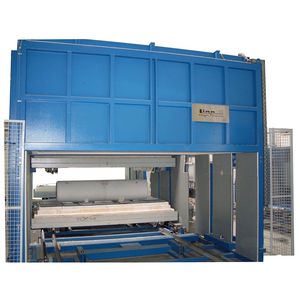
Chamber kiln FBV/GBVheatingmeltingcalcination



Add to favorites
Compare this product
Characteristics
- Configuration
- chamber
- Function
- heating, melting, calcination, casting
- Heat source
- electric resistance
- Atmosphere
- air circulating
- Maximum temperature
2,400 °C
(4,352 °F)- Capacity
1,000 l
(264.17 gal)
Description
annealing, bright annealing, graphitization/carbonisation, heat treatment, melting, reduction, remelting, sintering
The most important characteristics
Resistance heated by MoSi2, molybdenum, tungsten or graphite heater
Chamber furnace in bottom loader design
gastight
4-sided heated
Insulation of a combination of high-quality PCW-materials, graphite felt or refractory bricks (bubble alumina)
Extremely short heating up and cooling down times
High energy efficiency
Wide range of options for customer-specific adaption
Quality made in Germany
Easy handling
We make it possible
Linn High Therm is specialized in adapting its products to customer’s requirements. Please let us know if you need any modifications apart from our standard offer. We will do everything to satisfy your wishes.
Standard options
Different temperature controllers
Gassing unit for save operation when using flammable and explosive gases, burning-off device with flame supervision for save operation when using flammable and explosive gases
Safety package for safe operation
Gas warning system for safe operation when using flammable and explosive gases
Insulation for hydrogen operation, energy saving when using gases with high heat conductivity
Viewing glass for visual process control or additional pyrometer measuring
Condensate trap for “dirty” processes such as debinding, pyrolysis
Process guiding software for full control and documentation via PC
Catalogs
No catalogs are available for this product.
See all of Linn High Therm‘s catalogsRelated Searches
- Furnace
- Chamber furnace
- Electric furnace
- Heat treatment furnace
- Drying furnace
- Laboratory furnace
- Combustion furnace
- Stainless steel furnace
- Tunnel furnace
- Baking oven
- Industrial furnace
- Controlled atmosphere furnace
- High-temperature furnace
- Automatic furnace
- Vacuum furnace
- Continuous furnace
- Annealing furnace
- Programmable furnace
- Thermal furnace
- Air circulating furnace
*Prices are pre-tax. They exclude delivery charges and customs duties and do not include additional charges for installation or activation options. Prices are indicative only and may vary by country, with changes to the cost of raw materials and exchange rates.




